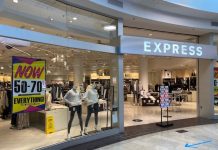Editor’s note: This is another in a series of stories focusing on Miller Prize winners for this fall’s Exhibit Columbus event downtown.
Talk about cashing in on a former bank building’s noted heritage.
A duo of Los Angeles architects will salute world-renowned designer Eero Saarinen’s celebrated Irwin Conference Center in downtown Columbus by withdrawing a bit of the structure’s drive-through past. It was the Irwin Union Bank and Trust from its opening in 1954 until 2009.
The effort, “Untitled,” by the Oyler Wu Collaborative, features canopies to link to part of that past.
[sc:text-divider text-divider-title=”Story continues below gallery” ]
“We really wanted to lock into something that already existed (on the site),” architect Dwayne Oyler said.
The white sheet-metal-and-tubes structure will be one of five temporary installations featured in the first exhibition element of Exhibit Columbus beginning Aug. 26 and stretching through November.
Organizers have estimated that the exhibition could draw at least 10,000 people from a regional area. But already on social media and elsewhere online, the star structures of the new event have been seen in recent weeks by thousands, according to participating architects.
Five design teams representing some of the nation’s top architects recently were named as the event’s Miller Prize winners. Each winning team gets $70,000 to design and build a temporary architectural creation to complement one of those five downtown structures.
Designers Oyler and business partner Jenny Wu, busy enough to be working worldwide in cities such as Taipei, Taiwan, became convinced they needed to be part of Exhibit Columbus when they came to Columbus several months ago.
“I thought, ‘Wow, it’s actually possibly for a community to use architecture as a way to better the city,” Oyler said, speaking recently from his California home. “I never really had seen architecture play such a significant role beyond the important aesthetic one.
“What I saw in Columbus was the idea that someone really had vision that wasn’t just about creating a handful of pretty buildings. I think it was a sense of ‘We can change the city with this.’”
Then he thought of his hometown in Coffeyville, Kansas, about half the size of Columbus, while Oyler was growing up.
“I thought, ‘If only the country’s 50,000 or so other Coffeyvilles, so to speak, realized that this matters,” he said.
Oyler and Wu have long been admirers of the work of Saarinen, also seen locally in North Christian Church and the Miller House. As much as they talk of trying to capitalize on how he used light in his designs, they want viewers to draw their own interpretation from their work to be built here.
Oyler mentioned that it’s not unlike a lyricist allowing a song’s audience to determine a tune’s meaning.
“I love the music analogy,” he said.
Richard McCoy, founder of Exhibit Columbus, believes the temporary works alongside long-noted local downtown buildings will offer people a new perspective on their city. His bigger aspiration is that the added architecture will serve as a catalyst for new, permanent works in and around the city in the future.
“I hope this allows a lot of people to see not only the Irwin Conference Center, but the (adjoining) plaza as well in a different way,” McCoy said.
Local sheet metal contractor Noblitt Fabricating Inc. will donate many of the materials for the construction of the temporary design. Noblitt owner Curt Aton emphasized that his firm simply wants to be a good team player that shows people that Columbus is marked by creators.
In a similar move, Aton’s company donated materials for artist Jonathan Nesci’s temporary work, “100 Variations: New Reflections on Eliel Saarinen and the Golden Ratio,” from 2014 in the First Christian Church courtyard. That’s significant especially since Exhibit Columbus organizers credit Nesci’s exhibit in part with the inspiration for their grand art and architecture project.
“We are not involved for the attention,” Aton said, adding that he was aware that the event already has garnered some national social-media attention. “One reason is that we really like art and architecture. And two, we like making cool things designed by people of the status of designers such as Oyler Wu Collaborative.”
Funding for Exhibit Columbus, part of a program called Landmark Columbus, has come from individuals, foundations and corporations around Indiana. The Heritage Fund — The Community Foundation of Bartholomew County also has been a key financial partner, and serves as the support for Landmark Columbus.




